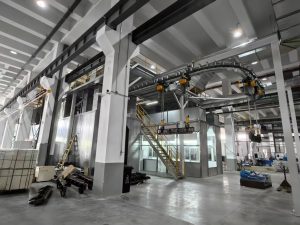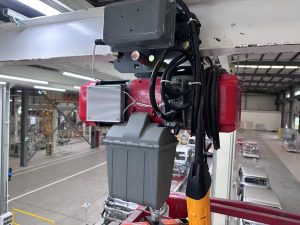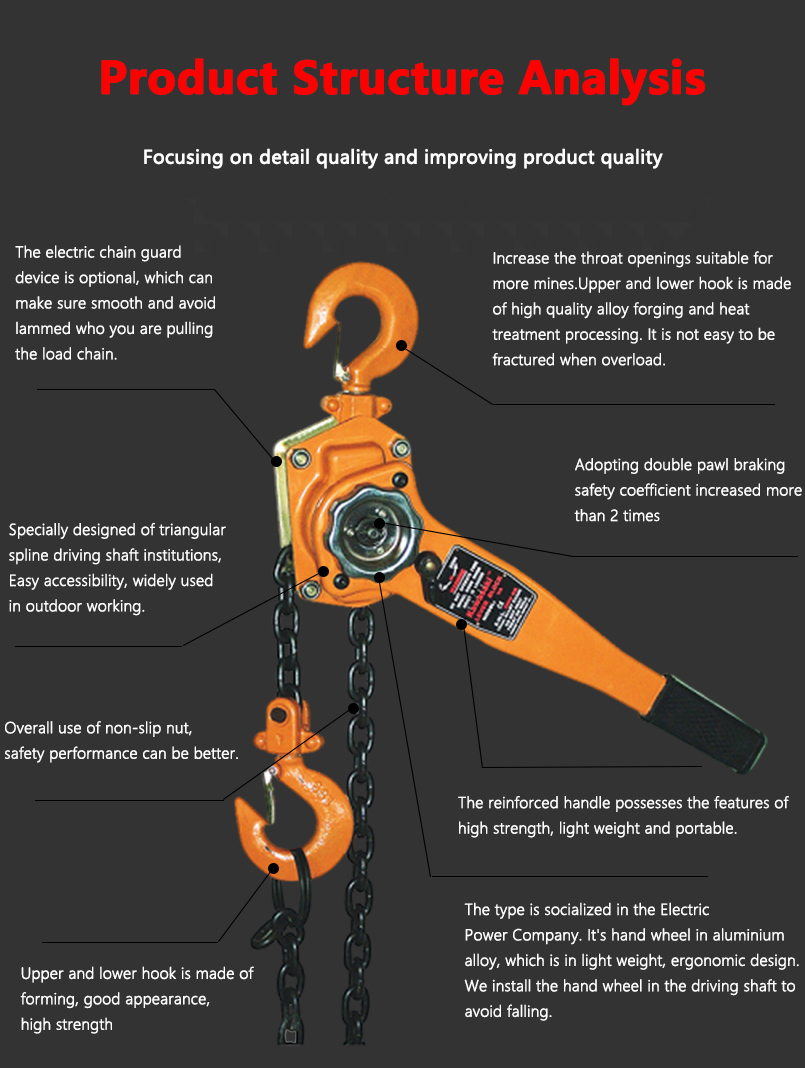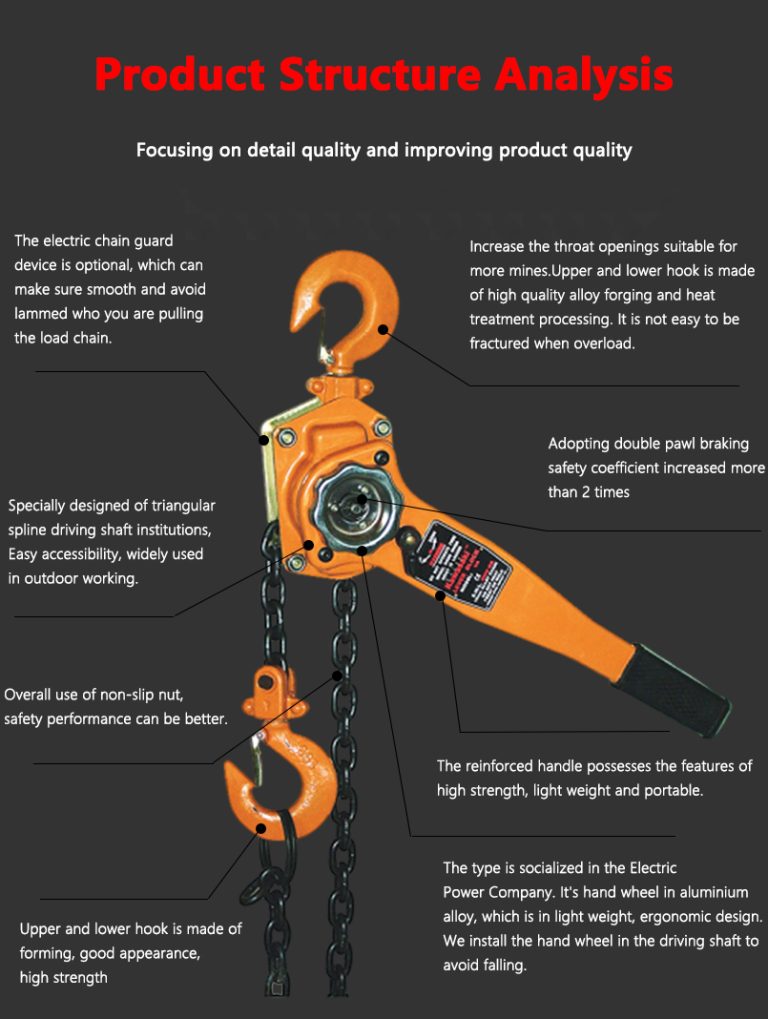Chain hoists are widely used in various industries to lift and move heavy loads vertically. They are commonly employed in construction, warehouses, factories, and other environments where materials need to be lifted, lowered, or positioned with precision. Chain hoists come in various models and designs, and choosing the right model is critical for ensuring safety, efficiency, and durability. In this article, we will explore the key differences between different models of chain hoists, covering manual, electric, pneumatic, and hydraulic models, their features, applications, and other important factors that affect their selection.
1. Manual Chain Hoists
Manual chain hoists are the most basic type of hoist. As the name suggests, these hoists rely on manual effort to lift and lower loads. They consist of a chain, a mechanical drive system, and a hook or lifting attachment. The user pulls the chain manually to lift the load, and the hoist’s gearing mechanism provides mechanical advantage, making it easier to lift heavy objects.
Key Features:
- Operation: Manual chain hoists are operated by pulling on a chain. The force required is usually minimal due to the gear reduction system that amplifies the user’s effort.
- Capacity: They typically have a load capacity ranging from 0.5 tons to 10 tons or more, depending on the specific model and construction.
- Portability: Since manual chain hoists do not require electricity or air supply, they are portable and can be used in remote or outdoor environments where power sources are unavailable.
- Cost: These hoists are generally more affordable than electric or pneumatic models, making them an economical option for lighter lifting tasks.
- Limitations: They require more manual labor and are slower than powered hoists, which makes them unsuitable for high-frequency lifting tasks.
Applications:
Manual chain hoists are ideal for applications where lifting is infrequent or where electricity or compressed air is unavailable. They are commonly used in workshops, garages, small factories, and construction sites for light to medium-duty lifting tasks.
2. Electric Chain Hoists
Electric chain hoists are powered by electric motors, making them ideal for tasks that require frequent or continuous lifting. The electric motor drives a gearbox, which then operates the chain to lift the load. Electric chain hoists are available in various designs, and the most common ones are single-phase or three-phase motor models.
Key Features:
- Operation: Electric chain hoists are powered by electricity, which makes them faster and easier to operate than manual hoists. The user can control the hoist using a pendant or remote control.
- Capacity: Electric hoists generally have a higher lifting capacity than manual models, with options available for lifting capacities ranging from 0.5 tons to several tons.
- Speed: Electric models offer faster lifting speeds, making them suitable for operations that require high throughput or frequent lifting.
- Safety Features: Many electric chain hoists are equipped with safety mechanisms such as overload protection, emergency stop buttons, and limit switches to prevent accidents.
- Energy Efficiency: While electric hoists require an electrical power supply, they are often more energy-efficient than pneumatic or hydraulic models, as they consume less power during operation.
Applications:
Electric chain hoists are commonly used in warehouses, factories, and large industrial operations where frequent, high-capacity lifting is needed. They are especially useful in environments where efficiency and speed are essential, such as in automotive assembly lines or heavy-duty manufacturing facilities.
3. Pneumatic Chain Hoists
Pneumatic chain hoists operate using compressed air to drive the motor that moves the lifting mechanism. These hoists are ideal for environments where electric power is unavailable or where there is a risk of sparks or explosions, such as in hazardous locations like chemical plants or oil refineries.
Key Features:
- Operation: Pneumatic hoists are powered by compressed air, making them well-suited for use in hazardous environments where electrical systems may pose a risk of sparks or ignition.
- Capacity: Pneumatic chain hoists can have a wide range of lifting capacities, from light-duty models with a capacity of 0.5 tons to heavier models capable of lifting several tons.
- Speed and Efficiency: These hoists can be faster than manual hoists but generally slower than electric models. They provide smooth, continuous lifting with a high degree of control.
- Reliability: Pneumatic hoists are often more reliable in challenging environments because they do not rely on electrical systems or motors, making them less susceptible to electrical failures.
- Maintenance: Pneumatic hoists require regular maintenance to ensure proper operation of the air compressor and other pneumatic components. Proper lubrication and air filtration are essential to prolong their lifespan.
Applications:
Pneumatic chain hoists are commonly used in industries like petrochemical, mining, and food processing, where explosion-proof equipment is required. They are also used in clean rooms, pharmaceutical environments, and other areas where electrical systems could present a safety hazard.
4. Hydraulic Chain Hoists
Hydraulic chain hoists use pressurized hydraulic fluid to drive a piston, which in turn moves the chain to lift the load. These hoists are typically used for very heavy lifting tasks, such as in shipbuilding or heavy construction, due to their ability to generate high lifting forces with relatively compact designs.
Key Features:
- Operation: Hydraulic chain hoists are powered by hydraulic systems that can either be manually operated or powered by a motor. The hydraulic fluid moves a piston or ram that drives the lifting mechanism.
- Capacity: These hoists have some of the highest lifting capacities, often ranging from 5 tons to over 100 tons, making them ideal for heavy-duty lifting operations.
- Precision: Hydraulic chain hoists offer precise control over lifting speeds, making them suitable for delicate or sensitive lifting operations where control is critical.
- Durability: They are known for their robustness and are ideal for environments that require heavy-duty, continuous lifting without frequent breakdowns.
- Energy Efficiency: Hydraulic systems are typically more energy-efficient for heavy lifting applications, as they can generate substantial force with less energy consumption.
Applications:
Hydraulic chain hoists are used in industries like shipbuilding, steel mills, and construction for lifting extremely heavy objects. They are also employed in vehicle repair shops, large equipment maintenance, and other specialized applications requiring high load capacity.
5. Differentiating Factors to Consider When Choosing a Chain Hoist
When choosing a chain hoist, several factors need to be considered based on the specific requirements of the task and environment. These include:
- Lifting Capacity: The weight of the load that needs to be lifted is the most important factor. Each type of hoist has different capacity limits, so it is essential to select a model that can handle the load safely.
- Speed of Operation: If high-speed lifting is required, electric hoists are usually preferred. Manual hoists, while cost-effective, are slower and less efficient for high-frequency use.
- Power Source: Electric hoists require access to a power supply, pneumatic hoists need compressed air, and hydraulic hoists rely on a hydraulic pump system. The availability of these resources in your environment will influence the choice of hoist.
- Environment: Consider the operating environment—pneumatic hoists are preferred in hazardous or explosive environments, while electric hoists are ideal for clean and controlled indoor spaces.
- Maintenance: Manual hoists are typically easier to maintain due to their simple mechanical nature, while electric, pneumatic, and hydraulic models require more sophisticated maintenance.
- Portability: For applications where the hoist needs to be moved frequently, a manual hoist or a compact electric hoist may be more practical than a large hydraulic or pneumatic system.

Conclusion
The selection of a chain hoist depends on a variety of factors, including the lifting capacity, speed, power source, environment, and maintenance requirements. Manual, electric, pneumatic, and hydraulic hoists each have their unique advantages and limitations. Understanding the key differences between these models will help ensure that the most suitable hoist is chosen for the task at hand, leading to greater efficiency, safety, and reliability in lifting operations.
In general, manual hoists are best for low-frequency, low-capacity applications; electric hoists excel in environments where speed and efficiency are critical; pneumatic hoists are the go-to for hazardous or explosive environments; and hydraulic hoists are the heavy-duty champions of lifting when it comes to extremely high loads.


